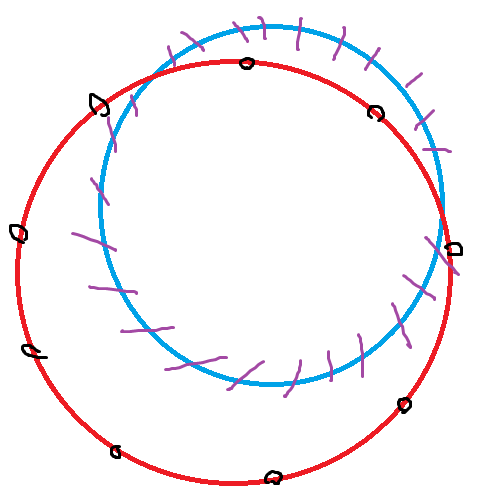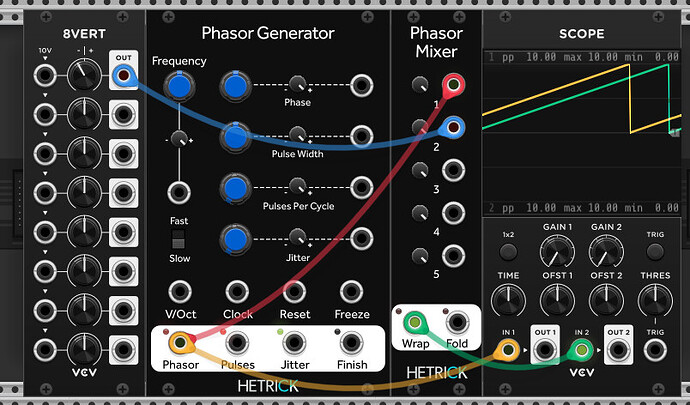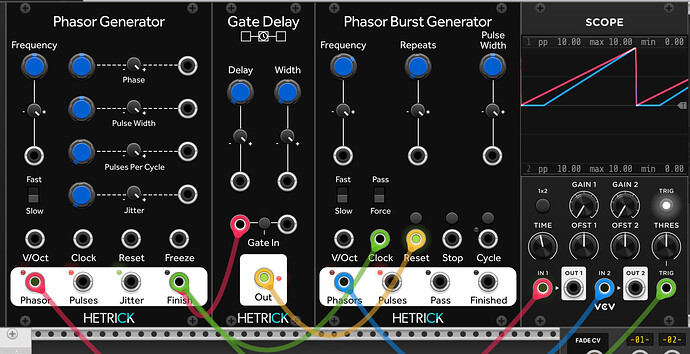i just use the first 2 channels of VCV Library - Grande MergeSplit4 it’s a little bit smaller
Hello there and friendly greetings! So, lately I have been enjoying the lysergic soundscapes of samplebrain: https://thentrythis.org/projects/samplebrain/.
Of course the first thing I thought about was “this thing HAVE TO BE a module in VCV!” Hence my question: is there a “samplebrain” module in VCV?
Or: is there a module that do the “samplebrain” stuffs?
Thanks in advance for any information and have a great week y’all! ![]()
Oh, that is a cool thing! I don’t think there is a module in VCV for it, but that would be cool to have, yeah! For something similar I usually use Autobreak Studio, it has inputs for samples, so I randomize it or sequence it and… Yeah, it does something similar without “tries to match each block with one in it’s brain to play in realtime” part. It’s not smart, it’s… something you should play with, it doesn’t do all the work itself, but I like it this way. Still would use this Aphex Twin module when and if someone makes it though…
It is GPL’ed… so someone could port it.
4ms and NLC both have some pretty extreme clock dividers on vcv. Highly recommended!
Hi! So I have this idea that might or might not be impossible to implement. In theory it’s very simple: two or more circles representing Euclidean sequences overlapping with each other. So for two circles it might look like this (I will use polygonal shapes for convenience):
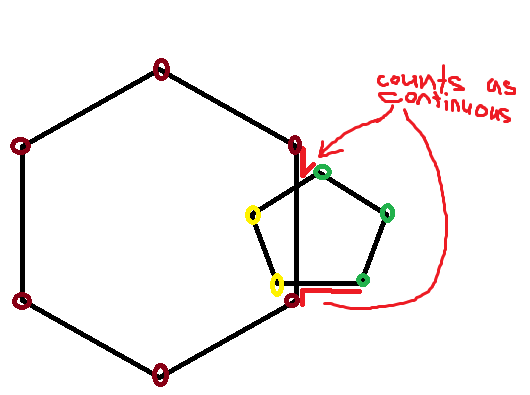
So we have a bigger shape and a smaller shape that overlaps with it. Bordeaux or Merlot colour represents the straight count. So if you have clock at 120bpm and have 12 steps overall with 6 of them being active, it would be 60bpm, right? So now after firing the last step before the overlap our virtual marker or a signal continues to outline the complex shape, so it can go right or left (or it might continue on the main shape, skipping the secondary one) and there are 2 yellow point and 3 green points. Math is hard, it should be 180bpm, but effectively yellow points along with bordeaux point form a triplet. And this triplet kinda ratchets there. The thing is, ideally in my mind we should be able to overlap this shape even if there are… say 5 beats instead of 2 like here (remember, there are 12 steps with 6 being active for the main shape), so If there are 5 steps, this triplet would be actually… a grouping of three notes over 5 steps, I don’t even know how you call it in music theory.
Anyway, the other possibility (and that would be great to CV the route) is a green notes one. And in this case that’s just 4 notes: 1 bordeaux plus 3 green. Just double the tempo, so 240bpm or… If the original note (the point on the main shape) was 1/4th, that would be 1/8th. I hope it’s not confusing YET. If you don’t like the shapes, there is another visualisation of it, it’s much simpler and UI-friendly:

Okay, so you might ask: why all the complications, all the explanations, it’s just euclidean generator with ratchets on some of the steps. Well, that’s not only about ratchets. Say you want a slower triplet - you should be able to do it with shapes:
So the blue one is the main shape here, but the red one is bigger – note that there are less steps – and it overlaps a lot of the main shape. So instead of say 20 steps, there might only be 2 or 6, depending on the CV (ideally).
Also it would be cool to have multiple secondary shapes, of course. And maybe even some shapes one level higher too. So like this:
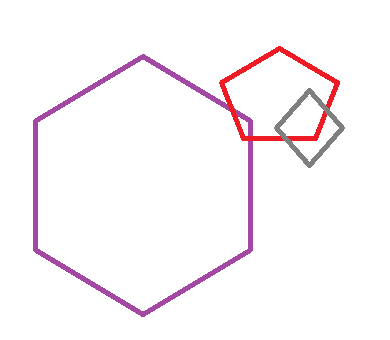
So what do you think? Is it even possible?
It’s certainly possible, and the polygons are a pretty way to visualize the relationships. The size of a module really constrains how complex you’d be able to make the patterns.
From time to time, I’ve thought of using a similar nested gear metaphor as UI for a sequencer/synth app, but it would be a full screen on it’s own.
You’d probably never see this in a physical Eurorack. Are there any modules with a usb port for a mouse? ![]() This isn’t a barrier for VCV but there are purists that only want modules that could be physical modules.
This isn’t a barrier for VCV but there are purists that only want modules that could be physical modules.
So I had this idea for a while and I think it might be implemented somewhere, but I can’t find it for some reason. it’s very simple: we have a quantized input signal that is 10v pp, but we want to compact it into 3v pp or even 1v pp without losing the note relations, so if it was C0-D0, we wouldn’t attenuate it to 0.00001v or whatever, it would still be C to D, but the octave would change. So this module should look if any notes are lower or higher than a set threshold and it would just add or subtract voltage V, where V is a natural number, meaning it is a positive integer. So it’s very simple, I guess it should be implemented somewhere probably in a quantizer that I haven’t used… Idk. But I do know that the second idea is much more interesting.
So this one is also about comparators or something like that. In my mind it is a mix of a mixer, splicer (or whatever you call it), compressor and whatever else. So What it is? It is a wave processor/comparator with two or more inputs and 2 or more outputs. Let’s simplify it to just one input for a moment, it would be easier to draw and explain it this way.
So we have an input and a number of manipulations that we can perform. First of all, we can just set it almost like a normal comparator - if input goes more than 1v, it outputs THIS WAVE, so not a gate and not a pulse. That is crucial. Alright. But what if we can manipulate this wave before it goes to the output? Say we divide it by 2, now every time it goes over the threshold, it gets a bit quieter than it should be. So it is a compressor, effectively. We can multiply it, making it an expander. It would be cool to have separate conditions to turn these functions on and off. So say when it goes over 1v, it starts compressing, but when it goes under 1v, it doesn’t turn off. Instead it turns off when it goes under -1v.
But the real fun begins when we have multiple waves and one of them or more manipulate the other ones. So say when the signal A goes over 1v, the module outputs signal B and When signal B goes over 1v, it outputs signal C and so on.
So which functions I have in mind? I think algebraic stuff is fun. So dividing/multiplying – by N, adding/subtracting – signal a, making it a power/square – of N, sin(n), cos(n), arcsin(n) – you know, all the fun stuff. Where N could be an internal or an external signal or a constant voltage. Other than that - send A – to OUT 1, send B – to OUT 1, mute – OUT 1, solo – out 1, sample – signal A, Where stuff before and after “–” are in two different lists.
I hope it’s not confusing, haha. Would be cool to have this thing. I guess it’s easy to make in BASICally and whatever, like pure data and Csound… Idk. I am not a programmer. Anyway, cheers!
hello there, first i’m not sure if it is the right place to ask, because i’m not a developer. i only have question about something, that i could find in the library.
idea or problem: i use phasors for my patches. therefore i use the hetrick @trickyflemming modules a lot. here is a picture of the phasor part.
what i want and not find is the following. i want to delay the phasor per step AND sync this phasor with the main one, so it is always in sync to the beat. delaying is possible with the nysthi module. shortening or length the phasor is possible with the divide&multiply module. but to be in sync i have to fasten the slew of the phasor. otherwise the phasor is not upto its highest point, if the main phasor is starting again. how could i fasten the phasor slew per step?
Thanks Karl
I use the ZZC modules for that.
The clock module can be expanded with the div expanders, and the big divider can be used to get every ratio of x/y measures. The “FN-3” gives you a phase based LFO, when set to ramp up it gives you a phasor with a phase control.
Also: Phasors are the best way to get rock solid sync with MindMeld Shapemaster or other buffer-based modules.
thank you for that, i know this module.
but i do not figure out, how to sync the ramp (phasor), if it is delayed.
the hetrick div/multi do the creating of longer phasors very good. with this i can set fully variable different length per step.
but if i put in a delay, the whole is delayed and therefore longer and not in sync. or if i change the mode button in div/multi it is sync, but not raised to the top.
so i need a module or idea to fasten the slope of the phasor to sync the top of the phasor with the top of the main phasor (stays in sync of the beat).
any idea?
You can use the “FN-3” and move the phase by the amount you want to delay it.
Synced phasor goes into FN-3, delay amount is controlled by phase, everything stays in sync as long as the driving phasor stays in sync.
aha, interesting. i will test it and come back here. thank you
I might be misunderstanding, but let me know if this patch works:
If you sum a phasor with a constant offset using the Phasor Mixer, then the Wrap output will be a delayed phasor. That will be more reliable and less CPU intensive than the audio delay. Additionally, when you remove or manipulate the offset, it will still be in sync with the original phasor.
thank you for the ideas, but they do not solve my problem. @Schabbes
the delaying of a phasor is working with both ideas and the phasor shift modul from hetrick @trickyflemming .
but my idea is to sync the delayed phasor with the bounderies of the master phasor.
therefore the delayed phasor must have a faster slope to sync. i want to have the phasor highest value to be timed/synced with the main phasor. so the delayed phasor starts later in the step, but will be in sync with the beat/sequence.
how can i change the slope of the delayed phasor?
I forgot my own Phasor Shifter module ![]()
I’d say @Schabbes solution is the best one since it allows you to comfortably edit where the secondary phasor starts and to ensure that it always ends at the same point as the input phasor.
Here’s a hackier solution that requires some finessing with the gate delay, the burst frequency, etc.
EDIT: Ah! I knew I had a voltage controlled version of this somewhere. Try Phasor->LFO with these settings (Skew, Width, and Curve turned the whole way down):
oh wow, i will check that tonight. especially the control of delay. for example 25,50,75% of steplength. that will result in a phasor with exact shorter notes.
thank you,
i tested it and works exactly how i want it. the shape cv defines the delay. the voltage is proportional to the step divider.
wonderful!
Do we have a physical modeling module for cymbals and metallic percussion–something like Chimera?
